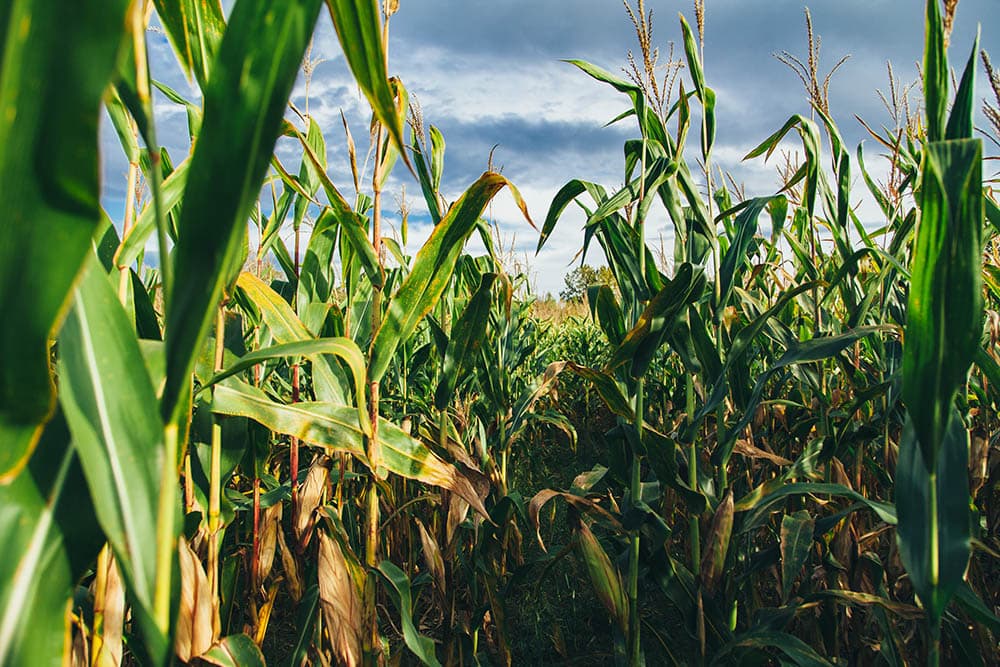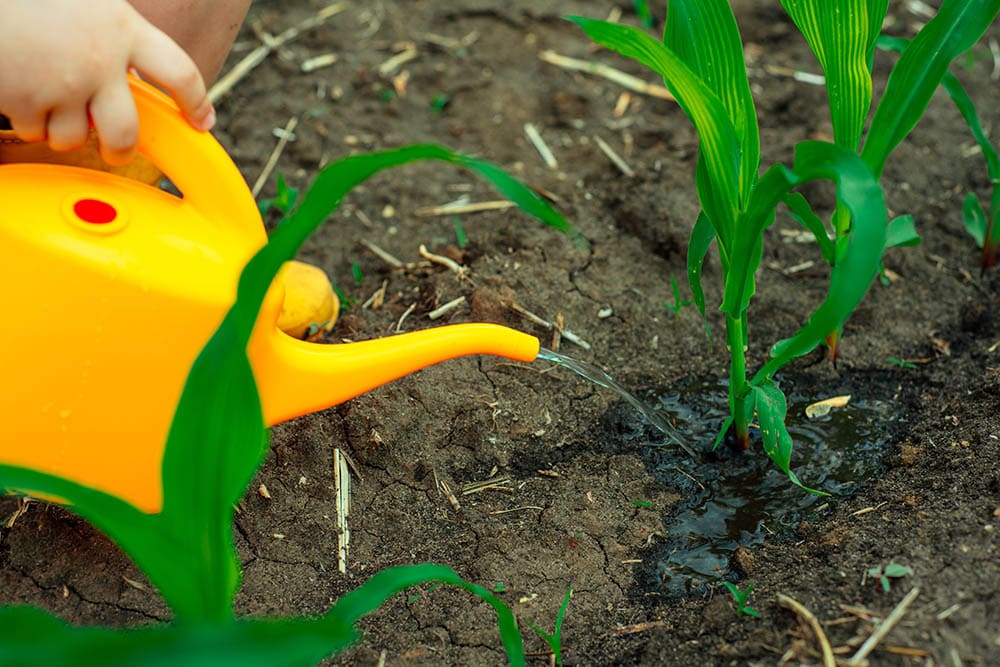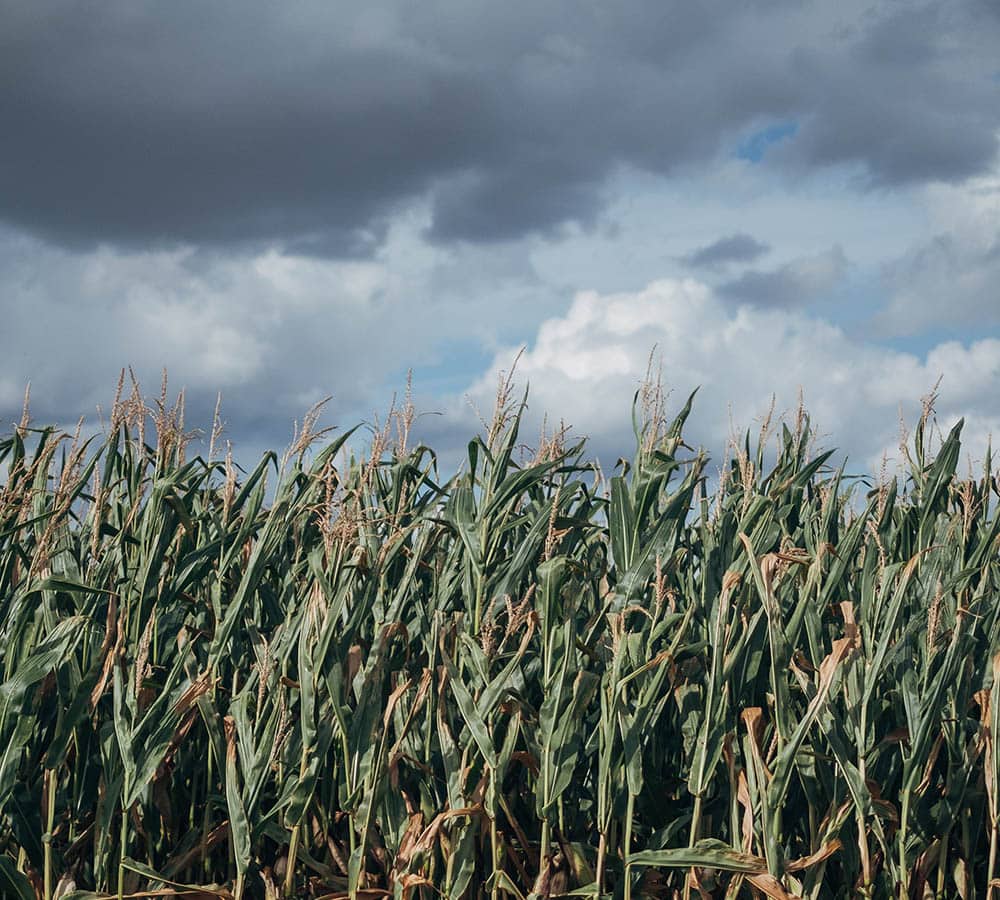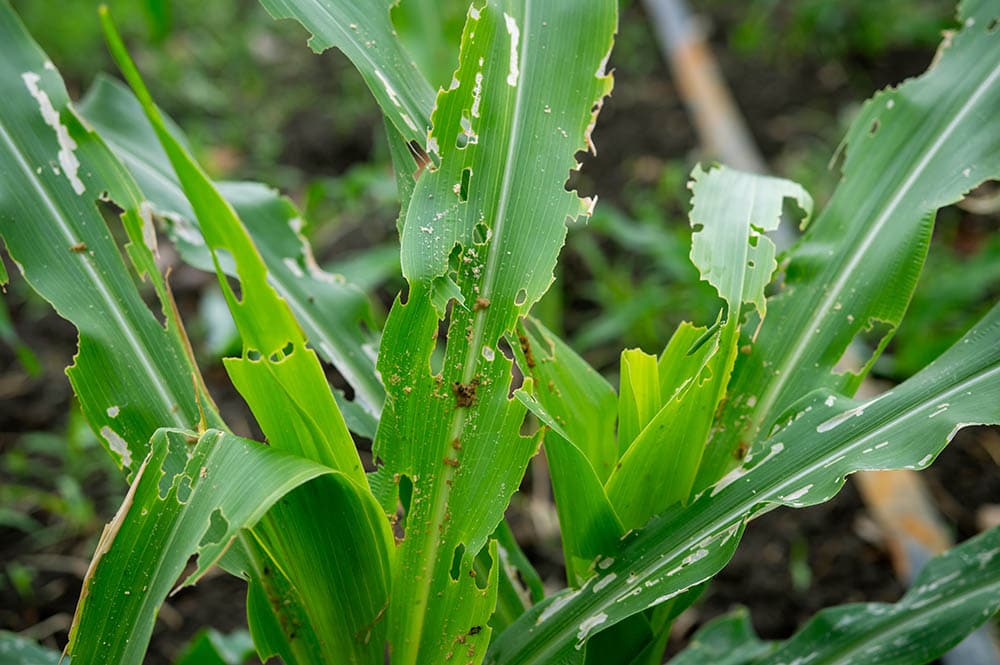Why Corn Plant Leaves Turn Yellow: 5 Reasons & Fixes
-

- Last updated:

Yellowing leaves mean your corn plants aren’t getting the resources they need to survive. It’s a concerning sight and one that needs swift intervention to save your crop from premature death.
Following proper planting and maintenance guidelines will typically eliminate the causes of yellowing corn plant leaves. Still, even the most disciplined gardener can face the occasional unexpected downturn. Learn why your corn plant leaves are turning yellow, and discover the often simple solutions to get them back on track.
The 5 Reasons Why Corn Plant Leaves Turn Yellow
1. Lack of Water

A corn plant needs tons of water throughout the season, and its needs only increase as the temperature rises. If you’re not watering it sufficiently or accounting for rising summer heat, it won’t take long for your corn leaves to fade to yellow, turn brittle, and fall off.
Corn Watering Needs
Water your corn plants at least once a week, ensuring they receive at least 1.5 inches of water. You may need to water them once every 2–3 days during the hottest summer months.
Corn grows roots up to 60 inches into the ground, so you need to soak the soil deeply with every watering. Consider adding 2–4 inches of grass clippings, wood chips, cardboard, or newspaper around your plants. Mulch will help retain moisture, keep the ground cool, and prevent weeds from growing.
2. Nutrient Deficiency
Corn plants need potassium, sulfur, and nitrogen, among other things, to thrive, and any deficiency will typically reveal itself in yellowing leaves.
Nitrogen travels from the roots to the top of the corn plant, so you can sometimes identify it by the yellow leaves at the bottom. Young plants may grow shorter and generally appear lighter in color. Mature plant leaves develop yellowing at the end that extends along the midrib and fans out slightly along the edges toward the tip, creating a V shape.
Potassium deficiency will also appear as yellowing on lower leaves. The edges fade in color and turn brown, or “fire.” Drought or underwatering are typical causes of potassium deficiency even if the soil levels are adequate, as the plant needs water to absorb potassium. Meanwhile, sidewall compaction around the seed can limit root growth, also reducing potassium uptake.
Sulfur doesn’t travel through the corn plant, so you’ll usually see this deficiency through yellow leaves at the top of the stalk. A lack of other minerals, including zinc, manganese, and copper, can also cause yellowing leaves.
How to Fix Nutrient-Deficient Soil
Manure, compost, and fertilizers will inject your soil with the missing component to fix your yellowing corn leaves. Frequent soil testing is crucial to reveal any necessary amendments.
Keeping your plants well-watered will ensure your plants are taking in enough nutrients. When planting, avoid sowing seeds too shallow or putting them in wet soil, as that can cause soil compaction that leads to stunted root growth.
3. Cool Weather

Cool weather and shady growing conditions can cause corn leaves to yellow. Cold soil conditions make it challenging for corn plants to absorb essential nutrients, particularly nitrogen. The problem worsens with excessive rain that soaks the soil and further stresses the plant.
How to Protect Corn in Cool Weather
You can’t do much about the weather, but you can cover your plants with plastic sheets or blankets when frost hits if the cold is an infrequent problem that they should be able to withstand. Otherwise, you may have to switch to containers.
When there’s no solution for the cold in your garden, portable potted plants will allow you to adapt to the changing weather. Keep them outdoors in a sunny area, and move them inside to a west or east-facing window when the temperature drops.
4. Overwatering
While too little water causes yellowing leaves, overhydration can also lead to problems, and they’re not always easy to overcome. Soggy soil can lead to root rot and bacterial infections, which will ultimately kill the plant.
How to Save an Overhydrated Corn Plant
Prevention is the best way to prevent the fungal or bacterial problems associated with too much water. Well-drained soil is a must. Modify your soil to improve drainage, and monitor your watering habits to keep the roots from standing in too much water.
You can try salvaging an infected plant by removing the rotten leaves, stems, and roots. Take the plant out of its container and shake the soil off. Clip back any browned or blacked rotten roots, and trim back withered and dying leaves and stems. Repot the plant in fresh soil, and apply antifungal or antibacterial treatments if desired.
5. Pests and Disease

Corn plants can fall victim to numerous pests and diseases, and yellowing leaves are a common sign of an infestation or infection. Persistent threats like aphids can kill plants quickly, and it’s crucial to manage any attacks immediately.
Pests living in the soil may cause leaves to yellow as well. Harmful earworms and nematodes can restrict the corn plant’s roots and decrease its ability to absorb nutrients, resulting in a pale green or yellow color.
How to Prevent Common Corn Threats
Organic insecticides targeting specific corn pests like aphids and earworms can control the spreading of damage to your crops.
- Removing aphids with a water stream
- Solarizing the soil with plastic sheets to eliminate nematodes
- Rotating crops to prevent nematode and earworm attacks
- Avoiding ALS herbicides or other toxic chemical agents
- Removing weeds and debris from around the plant
An infected corn plant will often be beyond repair, so the best way to handle it is to remove it quickly and safely. Dig up the plant and any surrounding soil and compost to keep it from contaminating nearby crops. Wash your hands thoroughly, and sterilize any equipment you used to take out the diseased plant.
Conclusion
After testing the soil, double-checking your watering schedule, and ruling out pests or diseases, you may still end up with yellow leaves. At this point, it could simply be age setting in, which unfortunately also has no cure. By taking steps to identify and resolve premature yellowing, you’ll avoid unwanted surprises and enjoy the longest, healthiest life from your corn plants.
Related Read:
- 5 Reasons Why Pepper Plant Leaves Turn Yellow and How to Fix it
- 10 Reasons Why Aloe Vera Plants Turn Brown & How to Fix it
Featured Image Credit: Jesse Gardner, Unsplash
Contents

